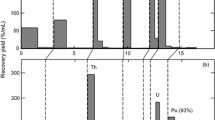Abstract
In non-suppressed conductometric ion chromatography, when a carboxylic acid eluent of low pH is used, the signal intensity (ΔHC) is proportional to the sum of the conductivity change caused by changes in the sample concentration ((ΔCS) as well as conductivity changes caused by changes in the eluent concentration ((ΔCe). This can be expressed as AHc=B((ΔCs)+B((ΔCe), where B is a constant. In this equation, (ΔCs is constant for any sample species. However, (ΔCe varies with changes in the sample capacity factors. This value is positive when the sample elutes before the system peak (k’s<k’e), and is negative when it elutes after the system peak (k’s<k’e). Therefore, the sample peak intensity (ΔHC) is enhanced prior to the system peak and is suppressed after it. These effects increase the closer the sample and the system peaks. The effect of this theory was proved by a determination of orthophosphate using a TSK gel IC-Anion-PW column and a 0.75 mM phthalic acid eluent. The detection limit of this method for orthophosphate (1×10-11 mol, with an S/N of three) was smaller (by a factor of 10–30) than those by previous conventional ion chromatographic. methods. Also, the interference of chloride or nitrate, often observed in the previous methods, was removed by suppressing their peak intensities. When this method was applied for the determination of orthophosphate in environmental samples, other interfering compounds were effectively removed by a column-switching system attached to the ion Chromatograph, and a trace level of the orthophosphate was determined.
Similar content being viewed by others
References
H. Small, T. S. Stevens and W. C. Bauman, Anal. Chem., 47, 1801 (1975).
D. T. Gjerde, J. S. Fritz and G. Schmuckler, J. Chromatogr., 187, 35 (1979).
H. Small and T. E. Miller, Jr., Anal. Chem., 54, 462 (1982).
S. Nakamura, N. Imaizumi, K. Hayakawa and M. Miyazaki, Bunseki Kagaku, 38, 573 (1989).
A. Yamamoto, A. Matsunaga, M. Ohto, E. Mizukami, K. Hayakawa and M. Miyazaki, J. Chromatogr., 481, 323 (1989).
A. Yamamoto, A. Matsunaga, E. Mizukami, K. Hayakawa and M. Miyazaki, Eisei Kagaku, 36, 332 (1990).
D. P. Lee, J. Chromatogr. Sci., 22, 327 (1984).
Y. Baba, N. Yoza and S. Ohashi, J. Chromatogr., 348, 27 (1985).
M. C. Mehra and C. Pelletier, Anal. Sci., 6, 431 (1990).
I. Yoshida, K. Hayakawa and M. Miyazaki, Nippon Kagaku Kaishi, 1986, 1046.
K. Hayakawa, K. Nomura and M. Miyazaki, Anal. Sci., 7, 967 (1991).
M. Miyazaki and K. Hayakawa, “Atarashii Ion Chromatography no Tehodoki (Introduction to New Ion Chromatography, in Japanese)”, Nankodo, Tokyo, 1986.
R. A. Robinson and R. H. Stokes, “Electrolyte Solution”, pp. 463–465, Butterworths, London, 1959.
Author information
Authors and Affiliations
Additional information
To whom correspondence should be addressed.
Rights and permissions
About this article
Cite this article
Hayakawa, K., Kato, A., Yamamoto, A. et al. Selective Peak Enhancement and Suppression in Conductometric Ion Chromatography and Its Application to the Determination of Trace Levels of Orthophosphate in Environmental Samples. ANAL. SCI. 8, 25–30 (1992). https://doi.org/10.2116/analsci.8.25
Received:
Accepted:
Published:
Issue Date:
DOI: https://doi.org/10.2116/analsci.8.25




